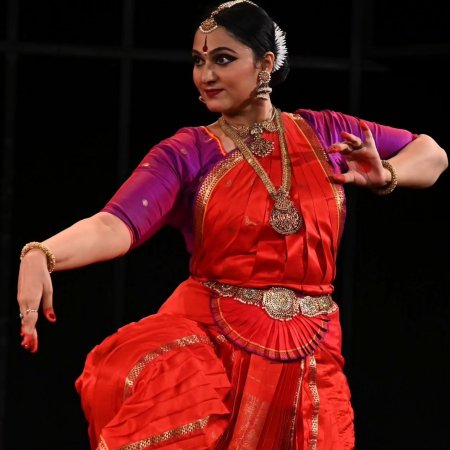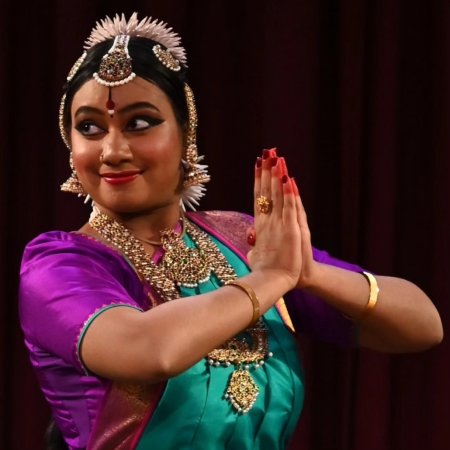
|   |

|   |
 e-mail: leelakaverivenkat@gmail.com Natya Vriksha centre stages two faces - of an inheritor and of a beneficiary October 9, 2024 Natya Vriksha, the school for Bharatanatyam run by senior dancer Geeta Chandran in Delhi, on two successive Saturdays showcased on the one hand, its inheritor Sharanya Chandran, at the Stein auditorium, and on the other, at the Triveni auditorium, one of the young beneficiaries of its dedicated dance propagation. That Geeta's daughter Sharanya Chandran, with the advantage of having grown up in a climate of dance and music from childhood, buttressed by special training in nattvuvangam, should present a program of Bharatanatyam, is hardly surprising. But that she should have got back to a full-fledged solo recital after her second motherhood, alongside her full time 10am to 5pm job, now centered round development, and all the family obligations with husband and two kids (notwithstanding exceptionally strong grandparental support), is proof of rare commitment to the art form. Aesthetically conceived, Sharanya's programme of Hymns to Hara, given her strong Saivite inheritance starting from the grandparents on both sides, began after a prayer to the Divasa Devata, Sani (it being a Saturday) by father Rajiv Chandran. The recital tone was set, with a delightful musical homage of Shiva Panchaksharam of Adi Shankara, "Nagendra Haaraaya, Trilochanaaya" sung and set to tune by vocalist K. Venkateshwaran. The dancer began with Gangaimuthu Nattuvanar's Chokkanada Kavutvam dedicated to Siva with his chedai virittu (open locks), as Eeshaana Dakshinamurty - the kaal maari aadiya Perumal, who is the parama Guru of all shiksha.  Sharanya Chandran (Photo: Sarabjit Singh Dhillon) With her commanding height, Sharanya's imposing figure on stage is somewhat different from what one comes across in Bharatanatyam - or for that matter, in any of our dance forms. Taller the person, the more challenges it poses in maintaining the araimandi, central concern of the dance technique. But Sharanya's nritta has always been a strong point, both in terms of its exact holding of movement profiles and also in terms of laya, with her deep understanding of tala. The centrepiece was the sringar varnam in Kamboji set to adi talam, "Sarojakshiro", wherein the lovelorn Nayika addressing her Sakhi in a flattering tone, as the one with the beautiful eyes, asks that she deliver her sringar message to the Lord Brihadeeswara, telling him to hasten (rammanave) to her side, for this is the samayamu (the ideal time) for love when Nature and Spring beckon. She complains of the arrows of Manmatha making life difficult for her. A feature of the concert was the music accompaniment. With the total understanding between Manohar Balatchandirane on mridangam and Varun Rajashekharan on ghatam, along with Geeta's assertive nattuvangam, the pure dance punctuations provided the right impetus for the dancer, with vocalist K. Venkateshwaran providing, in the sahitya parts, the most melodious bhav-soaked music. The great quality about this singer is providing involved music of high quality without his quiet presence in the team of accompanists ever drawing attention to itself. The dancer's stamina coped admirably with the physical stamina needed for a long varnam. The best aspect of the interpretative part was an underlying honesty, with Sharanya being her age and at no stage trying the demure, bashful, heroine act. In the post varnam presentation, the Padam in Kalyani, a Ninda stuti, "Yettai kondu ichhai kondai magale" has Parvati's mother wondering as to what her daughter could have seen in the idiosyncratic Shiva, so as to lose her heart to him. Enacting the feelings of one who called Shiva "Shuddha payittiyakaran" (a mad hatter), I felt that a tad more of exasperation was needed in the abhinaya interpretation, than the smile, attempting to persuade Parvati to change her mind. Changing over to the devotional mood posing no challenges for the dancer, was the next song with its overwhelming bhakti, Gopala Krishna Bharati's "Enneramum undan Sannadiyil" in Devagandhari, built round the devotee's ecstatic statement that all he desires is to be eternally facing the sannadi, feasting his eyes on the divine figure of the dancing God of Chidambaram, wedded to Sivagami. The real potential in the dancer came out towards the end, in the Ardhanariswar homage, based on Mithila Vidyapathi's poetry, set to music in the Ragamalika mode by K. Venkateshwaran. The dance interpretation based on Sharanya's own choreography brought out the complementing contrasts of the Shiva-Parvati Ardhanariswar to great effect, with a feel for dramatic counterpointing attitudes enshrined in one identity. ANANDITA NARAYANAN SHINES IN SOPAAN Not many Gurus think of how the student, after the arangetram, manages finding a dance slot, so as to be formally recognized by the dance presenters as a legitimate candidate for the performance arena. Usually it means just waiting hopefully, for the lucky break whenever it comes. To provide the sorely needed helping hand, Natya Vriksha has now introduced its SOPAAN (The next step) series, wherein the combined resources of both institution and guardians of students, present the respective competent young dancer in a solo performance, thus providing for much needed solo exposure.  Anandita Narayanan (Photo: Sarabjit Singh Dhillon) Anandita Narayanan performing at the Triveni auditorium showed herself to be an assured dancer, having participated in Natya Vriksha presentations, both singly and as part of the institution's group presentations. Starting with Pushpanjali, Sridhar Vasudevan's creation choreographed by Geeta Chandran, the dancer went on to the varnam in Poorvikalyani, a composition of late Guru Dandayudapani Pillai, "Saamiyai varachh cholladi Sakhiye" in the traditional format of the lovelorn Nayika asking her Sakhi to play messenger, conveying to her loved one Kartikeya, who is the glorious son of Shiva and Parvati and the pride of the whole universe, that she is awaiting his arrival, at this ideal time for love. Chiding her, for what one may conceive is the not too eager response, the Nayika demands why the Sakhi is tarrying and if her heart is made of stone. With the same team of musicians who accompanied Sharanya, along with Guru Geeta Chandran's nattuvangam plus joining in the singing at points, Anandita was blessed with the strongest of musical support. But what was noteworthy was that while the dancer delighted in the accompanists, being foot-sure and confident, she never had to look towards the musicians or Guru for cues. In the two interpretative post varnam offers, the first "Indendu vaccitivira" in raga Suratti, portrayed the angry Nayika crossed in love, the khandita, sarcastically demanding of the lover who had knocked at her door, as to how he could have accidentally come knocking at her door - for this was not the house of the fish eyed other woman. Taunting him further, she points to the full moon night and wonders as to how he could have lost his way, straying to the wrong house. Shutting the door in his face, she walks away, the feeling of one upmanship, some balm for the hurt of being crossed in love. The swadheenapatika or the Nayika is basking in the comfort of her smitten beloved, the greatest fan of her music and accomplishments. Besotted with love for her, not by a whisker will he cross the limits she sets on their relationship, the Nayika boasts to her friend. While Anandita has what it takes to be a convincing dancer of abhinaya compositions, with the years, this is an aspect of the dance, which will develop in nuanced subtlety of expression. To complete the evening was a sparkling Lalgudi Jayaraman Tillana.  Writing on the dance scene for the last forty years, Leela Venkataraman's incisive comments on performances of all dance forms, participation in dance discussions both in India and abroad, and as a regular contributor to Hindu Friday Review, journals like Sruti and Nartanam, makes her voice respected for its balanced critiquing. She is the author of several books like Indian Classical dance: Tradition in Transition, Classical Dance in India and Indian Classical dance: The Renaissance and Beyond. Post your comments Please provide your name and email id along with your comment. All appropriate comments posted with name and email id in the blog will also be featured in the site. |